Why own-root roses are healthier than grafted?
Potash didn't work for disease-prone own-root, such as Gruss an Teplitz (the parent of Dr. Huey). Gruss an Teplitz is known for blackspots and mildew, that's where Dr. Huey get his genes from. My 16 bands are clean, no aphids, except for Gruss ... he's covered with aphids, skinny weak stems, thin leaves. I gave Gruss calcium via gypsum, didn't help. I gave Gruss Sulfate of potash... didn't help. Gruss can't pick up potassium nor calcium ... I wonder about his offspring, Dr. Huey rootstock.
My 52+ own-roots are healthier than the 15 hybrid teas GRAFTED on Dr. Huey in my last acidic clay garden. Grafted roses don't have maximum access to water and nutrients, since it has to pass UP a restricted bud union. That bud union could be damaged by dryness in storage, winter, or soil acidity.
Someone asked if own-root is healthier. My answer is yes, since it's easier to find an own-root suitable for one's soil and climate.
1) Folks with acidic clay reported GRAFTED on Dr. Huey's decline ...multiflora rootstock is best for acidic soil.
2) I put a Knock-out grafted on Dr. Huey in a wet alkaline clay & poor drainage. That went downhill. I moved it, and put an own-root Romantica, very healthy, gave me 70+ blooms in 1st year.
3) I planted an grafted hybrid tea in a pot. It's clean in that dry pot, until I moved into wet clay, topped with acidic leaves ... broke out in BS instantly. I dug that up, and Dr. Huey's root shrank.
4) I killed a Knock-out grafted on Dr. Huey in a wet bed ... Dr. Huey was gone, it grew its own-root. Compare that to my killing a Knock-out in a DRY SPOT: it has both Dr. Huey and own-root together.
5) The bigger the root is compared to the top growth, the healthier it is. Own-roots are smaller, thus less demand on water and nutrients. Dr. Huey is a cross between Gruss an Teplitz (disease-fest) and Hybrid Wichurana (large climber), so its rootstock produce massive top growth, more susceptible to diseases.
My William Shakespeare own-root is small like a mini-rose, and blooms constantly. Compare that to much bigger WS grafted, which means more demand on water and nutrients ... and if these NOT met, diseases will occur. Dr. Huey is listed as susceptible to mildew.
I moved plenty of roses in my zone 5a: the difference between own-root and grafted-on-Dr.Huey: Own-root spread out, some horizontally from the main trunk, and can survive wet clay better. It's more efficient to transport water from a spreading root. Branches bloom better if trained sideway, rather than upward. Sap and nutrients flow better if it doesn't have to fight gravity.
Grafted roots have to go UP through a bud union, it's not an efficient water-transport system of HAVING TO PASS through that knob, esp. when that bud union is damaged. Grafted-on-Dr. Huey is great for a dry climate like California, but it's a big decline in Dr. Huey if buried deep in a cold zone, or wet clay. In my last house of acidic clay, I dug up a dozen BS-fest grafted hybrid teas, all roots shrank.
Below is own-roots Mary Magdalene (great myrrh scent), and Marie Pavie (musk scent that perfume my garden). Marie is in front, Mary is the bush behind - both are always clean even in humid and rainy weather:
Below is William Shakespeare 2000 own-root, it's small like a mini-rose, but blooms constantly in partial shade. I watered it less than 5 times per year, not much demand on fertilizer either.
Comments (34)
strawchicago z5
Original Author10 years agolast modified: 9 years agoI was wondering why Gruss an Teplitz has bad aphids in my less sun, humid, and rainy climate. I checked on Gruss's offspring Dr. Huey. Dr. Huey is the rootstock that most roses are grafted on. Here are the comments about Dr. Huey in HMF:
Tash wrote "My Dr Huey was very pink when I first moved into this house. It was also covered in BS and aphids. I got rid of the aphids and most of the BS and fed it and this year the blooms were much redder and truer to Dr Huey."
Posted by Anonymous on Feb 2004 in HMF's comment: "Disease susceptibility: Powdery Mildew. You aint kidding, it's terrible. ... For anyone else that has this growing, i suggest getting rid of it entirely, it's been a nightmare and has spread to all my 65 rose bushes. By the way I live in zone 08a."
Next comment by Dao Mai in HMF on Dr. Huey: "I can second the Disease susceptibility comment. It is a mildew magnet when it's in part shade. Funnily, some people comment that it tolerate shade! However if it is in full Sun and dry climate, it's OK."
Next comment posted by JMA, Feb 25, 2004 on Dr. Huey "I haven't had a powdery mildew problem with this rose and that may be because it gets an extreme case of black spot so that there are no leaves left to get powdery mildew. JMA
floridadon
10 years agolast modified: 9 years agoI often wonder if the rose varieties bred today, might not have much consideration given to the root system as grafting is an aid to overcome weak root systems, in some cases.
Related Professionals
Ashland Landscape Architects & Landscape Designers · South Elgin Landscape Architects & Landscape Designers · Forest City Landscape Architects & Landscape Designers · Burlington Landscape Contractors · Americus Landscape Contractors · Elmhurst Landscape Contractors · Goodlettsville Landscape Contractors · Los Banos Landscape Contractors · Marlborough Landscape Contractors · Mashpee Landscape Contractors · Mount Sinai Landscape Contractors · Northbridge Landscape Contractors · Tuscaloosa Landscape Contractors · Woodland Landscape Contractors · Crowley Landscape Contractorsstrawchicago z5
Original Author10 years agolast modified: 9 years agoThank you, Kim, for a comprehensive coverage on own-root vs. grafted. Kim Rupert (Roseseek) is the breeder of very disease-resistant roses, such as thornless Annie L. McDowell, and heat & drought tolerant Lynnie and Too Cute roses, plus many others.
Cantigny rose park here in zone 5a, alkaline soil, replaces their roses grafted on Dr. Huey every few years. Dr, Huey lasts longer in warmer climate. Tips for rootstocks:
For dry alkaline clay, Dr. Huey is suggested.
For acidic soil, Multilfora is suggested.
For nematodes as in Florida, Fortuniana rootstock is suggested.
For own-roots in my garden: Romanticas and French Meilland roses bloom well in my alkaline clay, pH 7.7, and don't mind my hard-well water at pH 8.
Own-roots musk like Annie L. McDowell and Marie Pavie do well in my alkaline clay, when given gypsum to counter-act the bicarbonates in my hard-water. Excellenz von Schubert, a musk, likes it more acidic, so I have to give it sulfur.
Own-roots multiflora-parentage like Blue Mist and Baby Faurax are not happy with my alkaline clay, pale leaves and stingy in blooming.
Austin roses, it depends: Evelyn, Golden Celebration, Wise Portia, Mary Magdalene, Pat Austin, Radio Times bloom well in my alkaline clay. Charles Darwin hates my alkaline clay.
The dark-green leaves do much better in my alkaline clay than the ones with pale leaves. The pale-leaves roses bloom when we get rain (pH 5.6), versus my pH 8 tap water.
This post was edited by Strawberryhill on Wed, Nov 6, 13 at 17:25
strawchicago z5
Original Author10 years agolast modified: 9 years agoI moved the info. into "Garden tips, garden diary, and challenges."
Here is a link that might be useful: Types of weed and types of soil
This post was edited by Strawberryhill on Tue, Nov 12, 13 at 10:21
strawchicago z5
Original Author10 years agolast modified: 9 years agoI waited for 2 years for Young Lycidas & Lady Emma Hamilton to be sold own-root, then I buy them. I no longer buy roses grafted on Dr. Huey. Our zone 5a winter kills the own-root plant above, leaving behind Dr. Huey root. Dr. Huey becomes eye-sore/messy climber in foreclosured houses.
So if no one water my roses or my house on sale, then I won't leave behind a legacy of messy Dr. Huey (looks like a non-blooming giant weed in zone 5a). The last time I killed a Knock-out of Dr. Huey, it took 1 hour to get rid of Dr. Huey's roots that extend 3 feet away. I can kill an own-root roses in 5 minutes.
Dr. Huey is hardy to zone 6b, and not my zone 5a. The rose park nearby replaced roses grafted on Dr. Huey every few years. Grafted on Dr. Huey lasts longer in warmer climate.
strawchicago z5
Original Author7 years agolast modified: 7 years agoAgree with what Julie stated below. Grafted-on-Dr. is great for dry & warm climate, but is diseased-prone in rainy climate, plus Dr.Huey-take-over is an eyesore in cold zone.
Right now on wet & rainy Oct. 27, my 2 worst-looking roses are grafted: Comte de Chambord grafted on multiflora is a blackspot-fest & zero blooms, while the other 2 Comte as own-roots are blooming & healthy foliage.
My Lavender rose (grafted on Dr. Huey) lost all its leaves from wet & rainy weather (drainage is excellent). But my own-roots retain all their leaves until frost hit. I have both Pink Peace (own-root) and Pink Peace (grafted on Dr.Huey) .. the scent is much stronger in the own-root, own-root require less fertilizer, and blooms are just as large & many petals as the grafted.
My W.S. 2000 as own-root went from a tiny bloom (2 inch) in its 1 year .. DOUBLE-THE-SIZE of the bloom in 2nd year into a 4 inch. bloom .. and the bush is compact & lovely. (StrawChicago).
My experience has been pretty much different. I encourage own-root because for me, grafted roses are a mess, weak and die within a couple of years. They are also more suseptable to disease. Granted, not all HTs do well on own-root and those you won't necessarily find in my garden (for more than a few years anyway).
I find that grafted roses will begin their decline almost immediately and within a 5 year period, will die.
There are always exceptions to the rule. I have two Hot Cocoa, one on Dr. Huey stock, one own root and both are doing just fine, large, disease free and killer prickles. The one on Dr. Huey is larger and meaner and honestly, I like the own-root better. It's smaller and blooms just as much.
I will also admit to leaning away from the Hybrid Tea, Grandiflora and Floribunda and toward the polyantha, miniature and shrub/rugosa/OGR varieties. I find my style of gardening doesn't want that formal look. I don't care for the square rose beds. I want my roses to blend in with the landscape for a softer look. HTs even in this type of situation stick out like a sore thumb.
I do keep HT, Grandiflora, Floribunda but in a cutting garden. That way if the rose dies in 5 years or so, I can replace it with something else. I do like these roses for in a vase and will keep them in the house.
I still have nearly all my own-root roses even after 20 years and they are still growing large and strong and bloom better than any of my grafted roses. They are harder to prune because they get so thick that it's hard to get inside them and clean them out for better air flow. I try to do this every few years.
This is just my personal experience in my garden. Every spring I get tired of the blackened canes and the dying roses. I've moved to the own-root because I don't get this. I don't like shoveling my roses for new ones each year. I get attached to my roses and want to keep them. I'm seriously not an annuals person. Nor am I rich enough to want to replace them every year. I don't care about showing the roses and don't really like the formality of the HT in the garden. I am after the bush, not so much the flower, but the flower adds a beautiful touch and if it's fragrant, even better.
I love, love, love the secret garden look and will do what I need to do to get and keep that look. In my garden own-root roses do much better than grafted ones. julie22 April 15, 2008 at 4:51AM
strawchicago z5
Original Author7 years agolast modified: 7 years agoBelow is from Ann, with acidic soil, and multiflora-rootstock. She likes cluster-type flowering better ... cluster-flowering like polyantha have multiflora-parentage thus do well in acidic soil. Dr. Huey also grows backwards within a year with my alkaline clay (pH near 8) if there's tons of rain. Dr. Huey was bred in dry California climate, and can't cope with acidic rain.
anntn6b(z6b TN)
First, from very old rose books: there are roses that were said to need to be propagated every three years or so. And the Rosarium at Sangerhausen does propagate large parts of their collection every three years.
There were also major issues with which of multiple rootstocks were used and I agree with Scott's initial posting except Dr. Huey grows backwards within a year in my soils. I was delighted to find an alternative to Dr. Huey slightly more than ten years ago and I was very pleased with the first ten years of growth on multiflora.
BUT, and this is a biggie, not all of my roses on multiflora have gone own root. Let's talk about Charles Austin, the climber. CA has grown well. It even avoided RRD that infected only one of its canes. Many years it had seven or more canes. One cane even laid along the ground, and no matter how I tried to cajole it, it did not root (even with asst hormones on its leaf nodes in contact with the ground). Now, at twelve, CA is growing backwards with only two good canes.
This is the same thing that happened with La France and Lucetta and The Lady and Die Welt. All on multiflora. But when we dug these out, I found good healthy roots, but that the rootstock had overgrown the scion and I had lost the scions. I wasn't getting multiflora canes emerging, just knobs that resemble cypress knobs.But I've fallen out of love with HTs. And much more in love with cluster flowered roses that seem to do so very well here. anntn6b(z6b TN)
Khalid Waleed (zone 9b Isb)
7 years agoA very good thread Straw. Absolutely agree with you on the advantages of own root. Besides all reasons mentioned by you, I would always go for own root due to one more reason...... it's a natural way of growing roses (or any plant for that matter). To me, every good rose should perform well on own roots and if a rose doesn't, there is some problem with the genetics of that rose and not with it being on own roots.
best regards
strawchicago z5 thanked Khalid Waleed (zone 9b Isb)strawchicago z5
Original Author7 years agolast modified: 7 years ago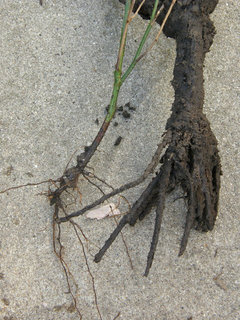
I bought Heirloom (grafted-on-Dr.Huey) for $4 at Walmart early June. Above is chunky root of Dr. Huey (on the right) that rotted in a wet spot. But Heirloom gave me an own-root (on the left).
Dr. Huey is many times bigger than that tiny-own-root, but Dr.Huey died in that wet clay within 6 months !! I spent 1 hour digging that hole down to 2 feet, but that didn't help with tons of rain.
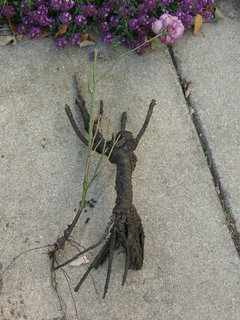
Above shows Heirloom sprouting its own-root (with a bloom) while Dr.-Huey rootstock is dead. Five years ago I bought Heirloom (grafted on Dr.Huey) and I didn't like the scent, and the bloom-color was super-gaudy purple ... that one ALSO declined in wet-clay.
For the past few months Heirloom lost all its leaves, I thought I died so I didn't dig that up. Then the own-root broke through and sprouted one bloom. That has the BEST SCENT EVER !! and the color is much better.
This is my 3rd experience with own-root smelling better than grafted-on-Dr.Huey. My own-root Double-Delight had a fantastic smell, but I DISLIKE the scent of my current Double-Delight (grafted on Dr.Huey), it's inferior & weird lychee.
Own-root Pink Peace is strong & wonderful scent, versus light scent on Pink Peace (grafted-on-Dr.Huey).
strawchicago z5
Original Author7 years ago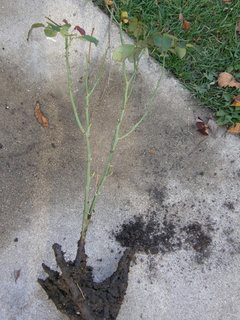
Above is Sundowner rose (grafted on Dr.Huey), except 3 stems rotted in wet clay, and only one stem is attached to Dr.Huey root-stock. See below how I damaged Dr.Huey rootstock by digging it up today, Nov. 7:

I re-planted Sundowner in the WETTEST spot possible, since I hope Dr.Huey will die, and I hope Sundowner grows its own-root. To make the soil fluffy to encourage own-root, I planted it 5 inch. below soil level, plus gypsum (white bag on the left), and pine bark chips (on the right).
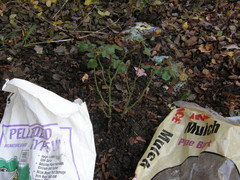
lavenderlacezone8
7 years agoVery glad that I have only own-roots and you've convinced me not to stray!
Very interesting pictures, thanks for posting.strawchicago z5
Original Author7 years agolast modified: 7 years ago
Above is an own-root Knock-out that I killed early June. Fifteen years ago it was grafted-on-Dr. Huey, but that bed is soaking-wet clay, plus I dumped an additional 8 inch. of soil on top. So it lost Dr.Huey completely and grew its own-root: very thick & fibrous after 15 years. The root is very dried out after 6 months in the compost, it was much thicker when fresh.I also dug up another Knock-out with BOTH own-root and Dr.Huey. Don't have a picture of it, but it was a "duplex" system: some tiny own-root on top, and a thick-Dr.Huey long root below.
strawchicago z5
Original Author7 years ago
Above is the shallow & cluster root of an azalea, which got killed by husband putting "rock-salt" to de-ice side-walk. Cluster root like azalea or multiflora-rootstock IS VERY SENSITIVE TO SALT. The root is actually even more shallow when I took off the clay at the bottom.
Duchess de Rohan (dug up recently) has a shallow & cluster root like above, and it likes acidic rain, but HATES SALTY HORSE MANURE.
strawchicago z5
Original Author7 years agoThe below Dr.Huey root is short due to poor drainage, but you can see 2 own-roots forming from 2 top-side-branches of Lavender Rose ($8 from Meijers).
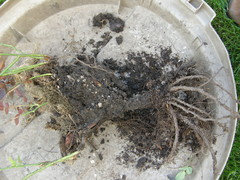
Below shows close-up of the top own-roots formed from the side-branches:
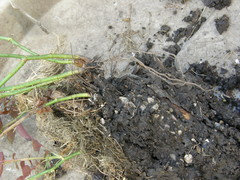
strawchicago z5
Original Author7 years agoRe-post some info. to compare rootstocks:
Multiflora-rootstock is not used in alkaline California due to its dislike for salt. Thus multiflora is best in high-rain climate.
These pics. are taken from the internet to show the characteristics of multiflora's 7 to 9 leaflets. Annie L. McDowell has leaves similar to multiflora .. and gave alkaline folks in CA a hard time .. that died on my sister in CA.

Below pic. belongs fo Hoovb from A Piece of Eden blog showing multiflora-rootstock as a shallow cluster:
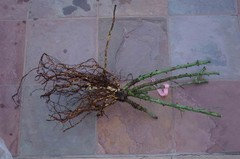
Phosphorus promotes branching both above, and below in the roots. Since multiflora is a cluster root, that would benefit from phosphorus (more branching).
strawchicago z5
Original Author7 years agoMoved the info. from another thread for HMF references:
When I dug up Gruss an Teplitz in Oct. to break up my hard clay. Its own-root was spreading WIDE and out like Fortuniana rootstock. Below is a pic. of Fortuniana rootstock which does well for Anna in hot & dry Southern CA:

Gruss likes to stretch out with its roots, I got 2 plants from the original 1 own-root. Gruss' root has thick & woody branching. Gruss can handle clay, but Fortuniana prefers loamy/sandy soil.
Below is multiflora rootstock, note that it's shallow & less spreading than Fortuniana. My Comte on multiflora has one tiny cluster like marigold's root.

Last is Dr. Huey rootstock (thick & chunky & tap-root) compared to tiny Heirloom own-root that sprouted off. Dr. Huey is more drought-tolerant with its solid mass, but hairy-own-root needs loamy soil & constant moisture. Dr. Huey is deep, so it can access my bottom clay for minerals, but hairy-own-root needs SOLUBLE fertilizer ... can't digest solid minerals like clay.
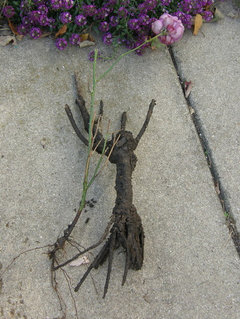
strawchicago z5
Original Author7 years agoMoved info. from another thread for references:
Years ago I planted Baby Fauraux: "small & slender leaves" in set of 5 to 7 (multiflora-parentage) .. that hated my alkaline clay and died through the winter. This year it's own-root Lady of Shalott "small & slender leaves" that's giving me a hard-time.
Those have multiflora-parentage and best in acidic & loamy & tons of rain & heavy on soluble fertilizer. The "small & slender" leaves dislike anything dense, clayish, and they hate alkaline-tap-water.
Own-root Lady of Shalott was wimpy in dense potting soil and refused to bloom, versus Dee-lish and Munstead Wood arrived mid-May with 6+ blooms.
I didn't understand the nature of "multiflora" until I dug up 2nd-year Comte de Chambord, grafted on multiflora. It's root is small-cluster the size of my Marigold's root, compare to the gigantic own-root Comte next to it, that's invading the hole. So I put "multiflora-rootstock" Comte next to the rain-spout, and it's happy at last.
When it rained tons, I watched all 3 swimming under the rain-spout: Kordes Barcelona, Comte, and Carding Mill. After week-long of fall rain, Carding Mill lost all its leaves, so I had to move that to a dry sot. Barcelona broke out in blackspot, so I moved that away from the rain-spout. But Comte-grafted-on-Multiflora is happy, gave one bloom at last.
Last year I had to IV Comte (grafted on multiflora) constantly with SOLUBLE fertilizer .. like 4 times the dose of acidic gypsum/sulfate-of potash before it pumped out blooms.
Advantage of multiflora-rootstock: can take tons of acidic rain, since its root doesn't produce much acid. Disadvantage: Less acid produced means it can't consume solid minerals, and have to be "spoon-fed" heavy doses of SOLUBLE fertilizer.
lavenderlacezone8
7 years agoThis is great info to have, thanks Straw!
None of my Kordes seem to be able to tolerate wet conditions, especially Earth Angel.
strawchicago z5 thanked lavenderlacezone8Khalid Waleed (zone 9b Isb)
7 years agoOutstanding stuff Straw and thanks a lot for the effort. This will help me a lot in compiling / updating my list of roses that do well on own roots.
Next year when I start building my house on top of the mountain, I want to enough enough own root roses that are capable of performing well in high heat and are also capable of handling monsoon. I might have very few grafted roses..... most of the roses that I will grow in my next house would be on own roots.
thanks and regards
strawchicago z5 thanked Khalid Waleed (zone 9b Isb)strawchicago z5
Original Author7 years agolast modified: 7 years agoKhalid: Will pH-test my rooting-mediums under pop-bottles (plastic tiny-green-houses). Some are rotting & growing mold inside pop-bottle, so I suspect the medium is acidic. In my thread "soil mix for baggie", you'll see how I root roses in 1-month, indoor, with a pop-bottle (no need to water).
strawchicago z5
Original Author7 years agolast modified: 7 years agoRoses grafted on DR. HUEY CAN SPROUT OWN-ROOTS !!
I dug up Pink Peace today, Dec. 28 .. it got up to 42 F, or 5 C, the ground is thawed. I tested the soil pH, it's alkaline (thanks to red-lava-rock), but poor-drainage. Dr. Huey-rootstock is deep, so I dug down to 2.5 feet, 0.8 meter. Took out 4 large buckets of dense clay, plus broke up the dense clay at bottom with 20 cups of gypsum, plus 1/2 bag of pine-bark-mulch.
Note Pink Peace gave me an OWN-ROOT at left side, plus OWN-ROOT sprouting on upper level, plus Dr.Huey-rootstock at bottom. Digging deep, and burying Dr. Huey deep gave me an own-root. Pic. taken Dec. 28, 2016.

Below Pink Peace bloom, taken end of Sept. 2016, was from the lowest branch-own-root that sprouted in front of Pink Peace (grafted on Dr.Huey).
I had Pink Peace as own-root in 2013 that died over the winter .. it gave more petals & plus better scent in my bouquets.

strawchicago z5
Original Author7 years agolast modified: 7 years agoToday is Jan, 1, 2017 at 37 F, or 3 C. Since it's dry & sunny I dug up Stephen Big Purple own-root hybrid tea to fix drainage. Dug up a large wheel-barrow of soaking wet sticky clay to throw away, and fixed drainage down to 2.5 feet with gypsum & pine-bark. That hole has the overflow from rain-barrel, dumping 32 gallons of water per 1/2 hour. It was hard work, but the kale smoothie gave me energy.
I find that digging in DRY WINTER result in the least damage to root. Below picture, taken Jan 1, 2017 shows how big a 5-year-old own-root rose is:
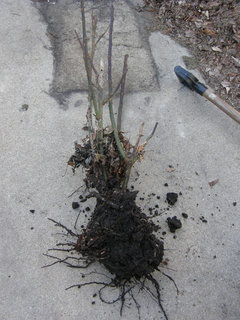
I dug up 15-year old Dr.Huey before, and the root was more shallow than own-roots. Compare the own-root above to below 2-year old Dr.Huey (Pink Peace):

OWN-ROOT Austin roses like Golden Celebration or Christopher Marlowe were even bigger & deeper. Below picture, taken on Jan 1, 2017 is close-up of 5-year OWN-ROOT Stephen Big Purple rose:

Below pictures taken when Stephen Big Purple was 2nd-year own-root:


Below pic. is Stephen Big as 3rd-year own-root, note the increase in petal-count as own-root got bigger:
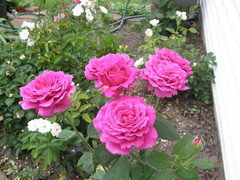
strawchicago z5
Original Author7 years agolast modified: 7 years agoSince the weather will be 37 F tomorrow, I will move Comte de Chambord (grafted on multiflora) to a soaking wet bed & partial shade. Will post pic. of multiflora-rootstock. That one needs tons of rain & soluble fertilizer to bloom.
lavenderlacezone8
7 years agoThose pictures are extremely helpful, especially in visualizing how they might look in a pot. I'm always worried about crowding them!
strawchicago z5 thanked lavenderlacezone8Khalid Waleed (zone 9b Isb)
7 years agoIndeed priceless pics. No one posts photos like these on the web. Thanks a ton Straw.
strawchicago z5 thanked Khalid Waleed (zone 9b Isb)strawchicago z5
Original Author7 years agolast modified: 7 years agoToday January 2, I dug up Comte de Chambord, grafted of Multiflora rootstock. Bluegirl had it for a few years in her alkaline Texas, didn't bloom well so she gave to me, since I have more rain. As multiflora-rootstock, Comte bloomed OK in spring but stingy afterwards, while my 2 other Comte as OWN-ROOT bloom profusely with 4 flushes until snow hit.
I have Comte-on-multiflora for 2 years. It's so stingy in the summer I moved it next to the rain-spout in July. Its root was the same size as my marigold !! It became even stingier, despite my using the entire bag of coarse sand to make my clay fluffy. So I dug up Comte grafted on multiflora today, Jan 2, and IT WAS THE MOST PATHETIC multiflora rootstock that I had ever seen in my 3 decades of growing roses !!
I already posted the study that showed Fortuniana-rootstock produces more blooms than Dr. Huey, and Dr. Huey produces more blooms than multiflora-rootstock.
Left side is Comte de Chambord grafted on multiflora rootstock, right side is a snapdragon annual flower root (sown from seed !!). The snapdragon-flower root is actually larger than the multiflora-rootstock.
This 4+ year-old Multiflora-rootstock actually SHRANK in my alkaline clay, despite tons of acidic rain. And it REFUSED to give me own-roots at the side like Dr. Huey-rootstock. Picture taken today, Jan 2 at 39 F or 4 C.
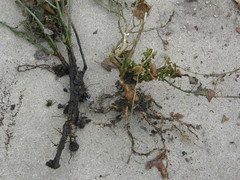
Re-post info. from Oct. 2016: Comparing Dr. Huey-rootstock, Multiflora-rootstock, and Fortuniana-rootstock from below link, worth reading:
http://roses4az-mevrs.org/wp-content/uploads/An-Overview-of-Fortuniana.pdf
Here in the Desert Southwest, with our generally alkaline soils and extreme temperatures, we find that r. multiflora has a shorter life span, losing its vigor after five years. While fortuniana bushes had superior root systems, they had difficulty with the harsh & cold English climate.
In a study over several years, Dr. McFadden budded two hybrid tea varieties, Queen Elizabeth and Tiffany, onto three different rootstocks. After counting the number of blooms produced over many growing seasons, the varieties budded onto fortuniana produced significantly more blooms. The fortuniana plants produced about THREE TIMES the number of blooms as those on multiflora and TWICE as many as on Dr. Huey.
Additional benefits of Fortuniana include increased resistance to gall, stem dieback, and root disease, such as Phytophtora and Pythium. Bushes planted over 40 years ago in Florida are still thriving. On this rootstock, plants are heavier feeders, as they have five times the feeder roots of more common varieties."
http://roses4az-mevrs.org/wp-content/uploads/An-Overview-of-Fortuniana.pdf
strawchicago z5
Original Author7 years agolast modified: 7 years agoToday, January 2nd, I also dug up Jude the Obscure .. it was a healthy in a pot, then blackspot when I planted into my alkaline clay early fall. Winter-survival is good, canes are all green despite -10 to -13 F earlier this month.
Below is Jude the Obscure as less-than-1-year OWN-ROOT .... I grow it as a tiny rooting shorter than my finger in May. Note how MUCH BIGGER THE ROOTBALL is, it's a cluster-root with many tiny-feeder-roots, thus need constant moisture. Picture taken January 2, 2017:

Comare the above rootball of Jude as OWN-ROOT (less than 1 year), versus the shrinking 4-year old multiflora-rootstock of Comte de Chambord in below pic, on the left. The right side is a snapdragon flower root (sown from seed). Picture taken Jan. 2. 2017:
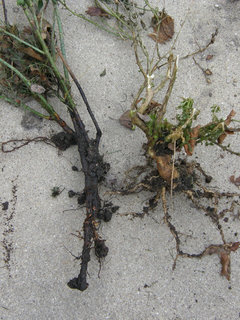
Kelly Tregaskis Collova
7 years agolast modified: 7 years agoThank you for the information and pictures. Very helpful. I wonder what it is that multiflora dislikes so much, the compact clay with little available oxygen or certain nutrients?
strawchicago z5 thanked Kelly Tregaskis Collovastrawchicago z5
Original Author7 years agolast modified: 7 years agoKelly: Multiflora's native land is acidic soil & rainy zones (East coast). Multiflora has 7-leaflet thus like it wet. Multiflora doesn't tolerate salt, and clay is saltier with higher nutrients. Multiflora has single-petal white flowers, so its roots is quite simple, and doesn't like fertile soil like clay.
Both snapdragon and marigolds have fancier & more petals & more colors flowers than multiflora-rose, so these annual flowers have larger and tougher roots for clay soil. Khalid holds the record for the most petals & deepest colors ... his roses are grafted on Centifolia (cabbage rose with zillion of petals & deep colors).
Comte de Chambord is the easiest rose to root .. I'm rooting 2 of them indoor right now ... band-size within a month. But Comte grafted on multiflora REFUSED TO GROW OWN-ROOT, like Dr. Huey-rootstock.
Below is an internet pic. of single-white rose of Multiflora, plus its 7 leaftlets:

strawchicago z5
Original Author7 years agolast modified: 7 years agoMultiflora-rootstock declines even for acidic & high rain region like anntn6b(z6b TN), she wrote: "This is the same thing that happened with La France and Lucetta and The Lady and Die Welt. All on multiflora. But when we dug these out, I found good healthy roots, but that the rootstock had overgrown the scion and I had lost the scions. I wasn't getting multiflora canes emerging, just KNOBS that resemble cypress KNOBS. anntn6b(z6b TN)
*** From Straw: Note the KNOBS that grew out of my multiflora-rootstock after 4 years, those KNOBS prevent roots from getting the nutrients. Below Comte on multiflora (left side) gave one-tenth the amount of blooms as my OWN-ROOT Comte. I don't see the normal hairy roots, I see KNOBS !!
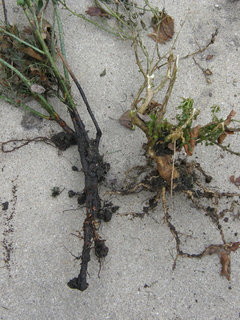
lavenderlacezone8
7 years agoStraw, those pictures are just fascinating and I really appreciate you posting them.
Newbie question for you though. When the soil is off of the roots like that, does that hurt them in any way? I always get nervous during planting if the soil falls away even the least bit!strawchicago z5 thanked lavenderlacezone8strawchicago z5
Original Author7 years agolast modified: 7 years agoLavender: You are right about soil off the root will hurt roots. When I dig up roses, I try my best to keep the soil intact. THE WORST THING ANYONE CAN DO IS TO DUNK THE ROOT INTO A BUCKET OF WATER, that will make the soil fall off, and destroy the tiny & tender feeder root.
I didn't bare-root Dr. Huey-rootstock nor multiflora-rootstock, there's an absence of "feeder-roots", so those can't hold on to soil, despite my sticky clay. GRAFTED roses are prone to diseases due to less feeder-roots (less water and nutrients).
But OWN-ROOT Jude has plenty of "feeder-roots" which soil sticks to form a round root ball. Same with OWN-ROOT Stephen Big, lots of tiny roots that soil clings to. Jude was 100% healthy in a loamy pot with its massive root-ball & lots of feeder-roots.
ADVANTAGE OF OWN-ROOT: way more feeder-roots than grafted-roses. More feeder-roots = more efficient in getting water and nutrients.
strawchicago z5
Original Author7 years agoMove info. from another thread into here, to show Centifolia rootstock: very drought tolerant.
Below is Centifolia root (Le Nia Rias) which I killed due to dozen of suckers. It took me over 2 hours to get rid of all the suckers at 2 feet deep. The roots shown is only 1/6 of its root-system. Roots are like steel-cable, the $20 clipper could not handle that, so I had to use the $60 Fiskar tree-clipper to chop the root. This root system can go through rock-hard clay easily.


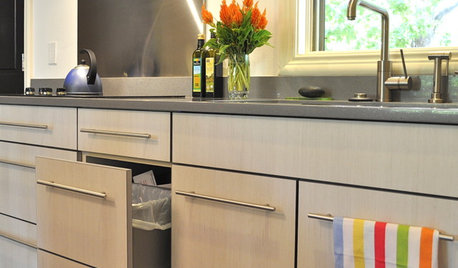




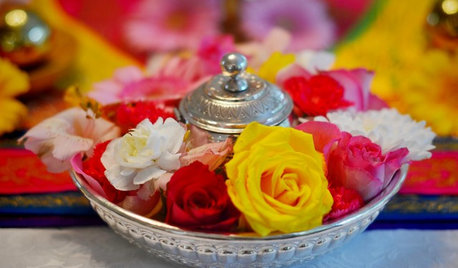









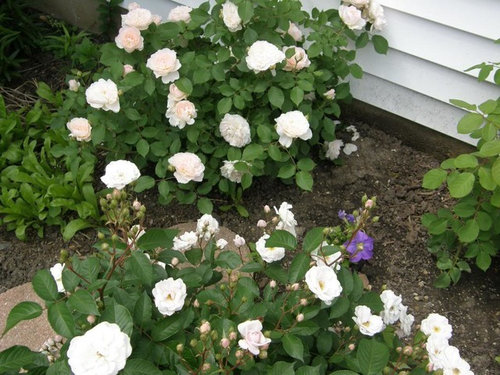





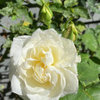
roseseek